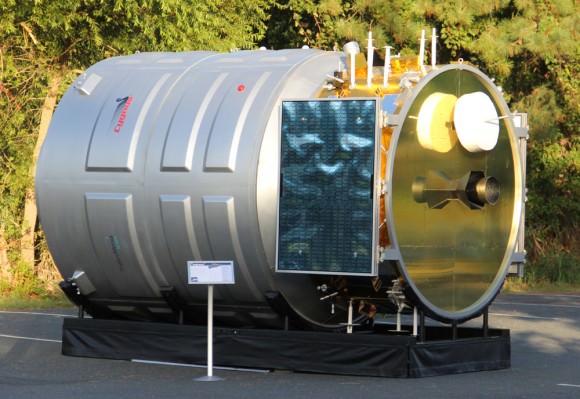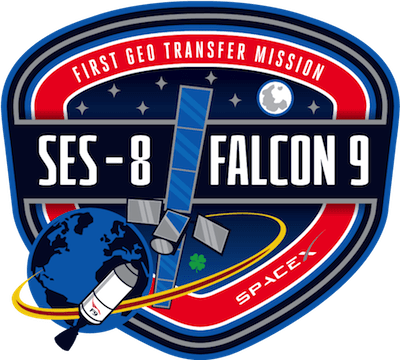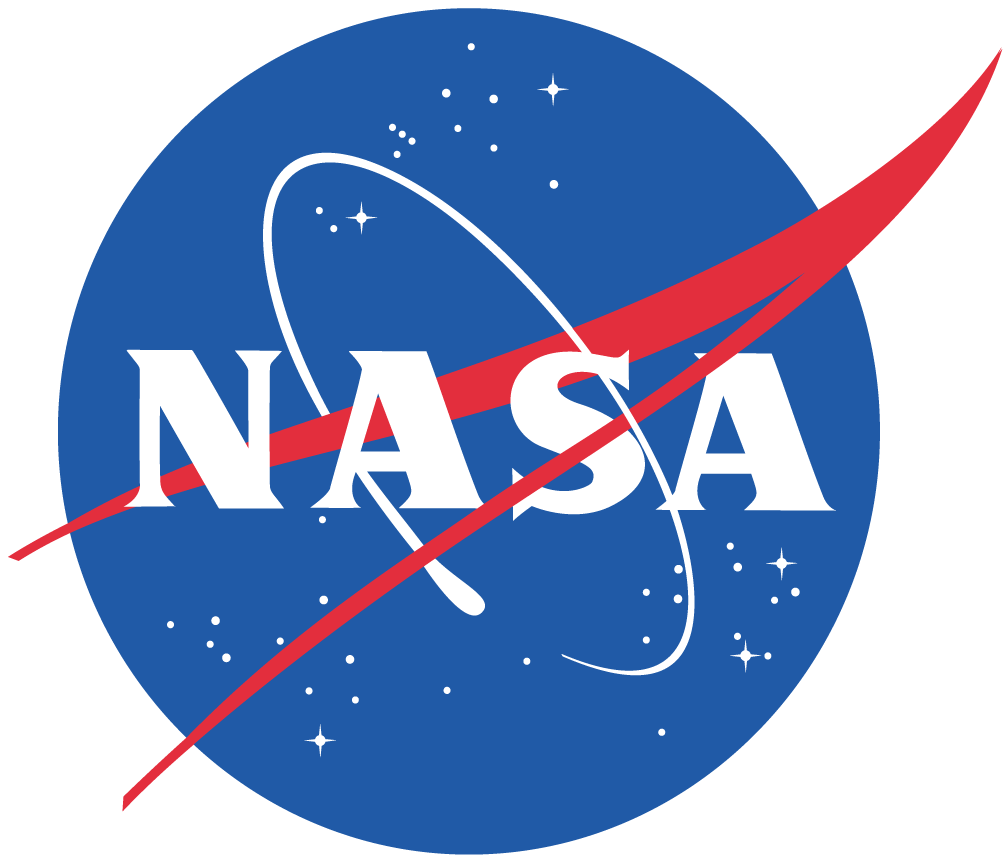Host: Fraser Cain
Guests: David Dickinson, Matthew Francis, Casey Dreier, Sondy Springmann
Continue reading “Weekly Space Hangout – December 6, 2013 – Zombie ISON, Jade Rabbit, Lovely Venus and Naked-Eye Nova”
SpaceX SES-8 Flawlessly Beautiful Dec. 3 Launch – Photo and Video Gallery
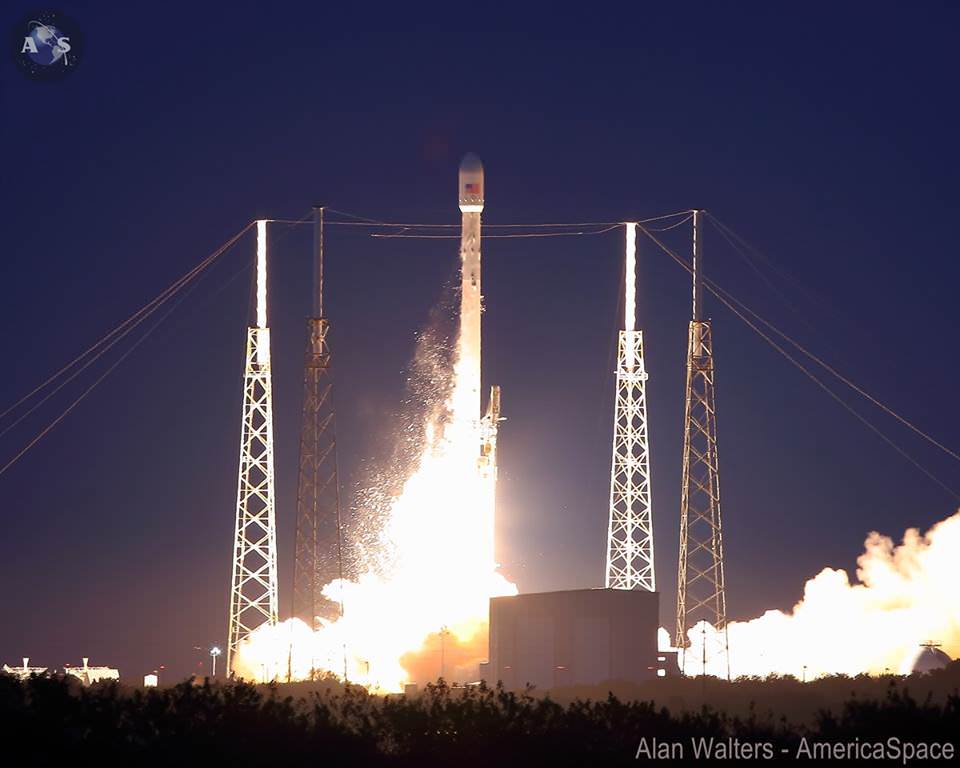
CAPE CANAVERAL AIR FORCE STATION, FL – The flawless blastoff of SpaceX’s next generation Falcon 9 rocket on Tuesday Dec. 3 put on a spectacular sky show along the Florida Space Coast that was both beautiful and unforgettable – besides being truly historic as the firms first ever delivery of a commercial space satellite to the lucrative market of geostationary orbit.
For your enjoyment here’s a collection of photos and videos from fellow space photojournalists of the 5:41 p.m. EST sunset launch from Space Launch Complex 40 (SLC-40) at Cape Canaveral Air Force Station, FL.
Following a pair of launch scrubs last week on Nov. 25 and Thanksgiving Day Nov. 28 caused by issues with the powerful new Merlin 1-D first stage engines, the third time was fat last the charm as the Falcon 9 blasted precisely at the opening of the 86 minute launch window.
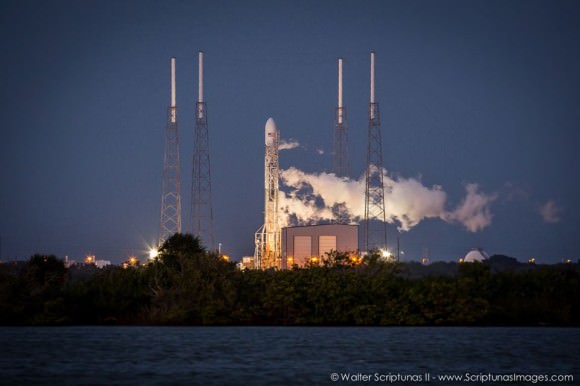
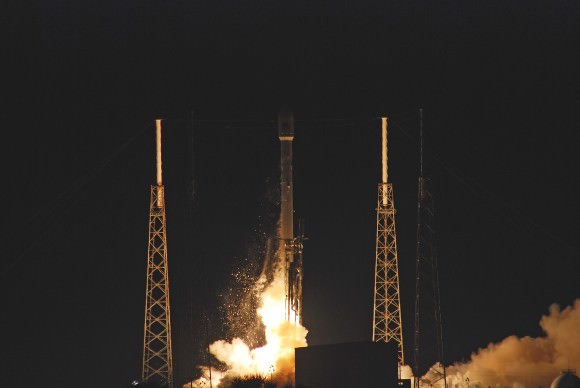
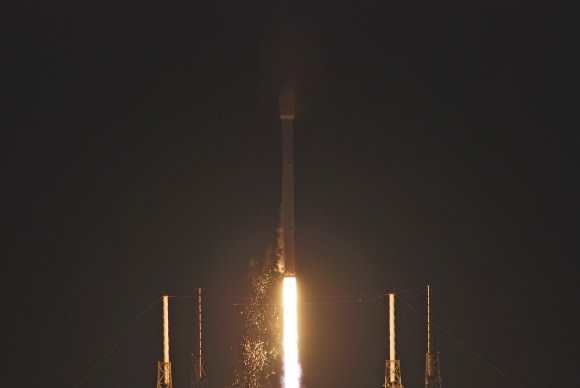
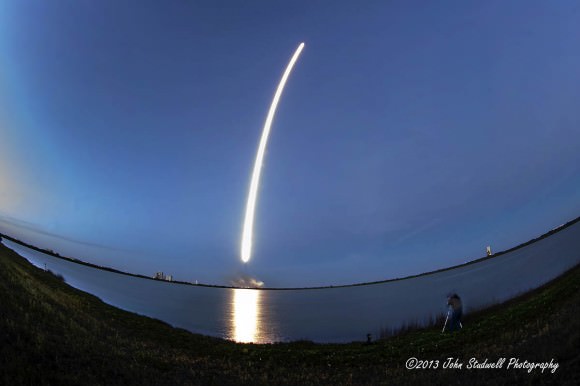
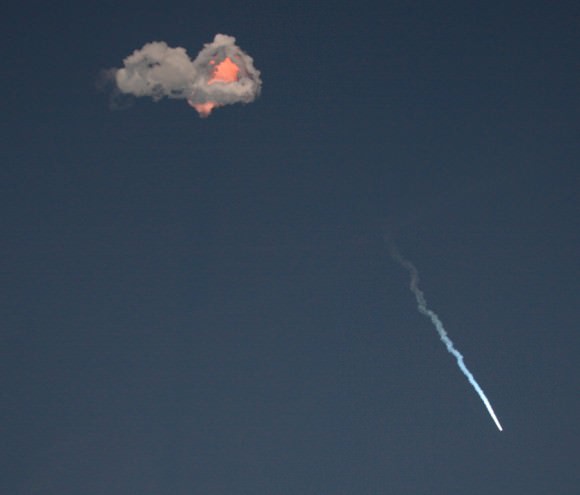
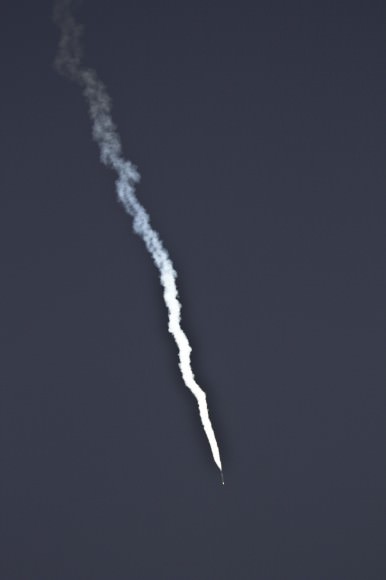
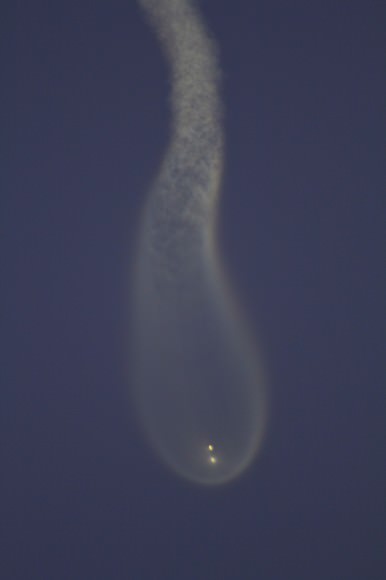
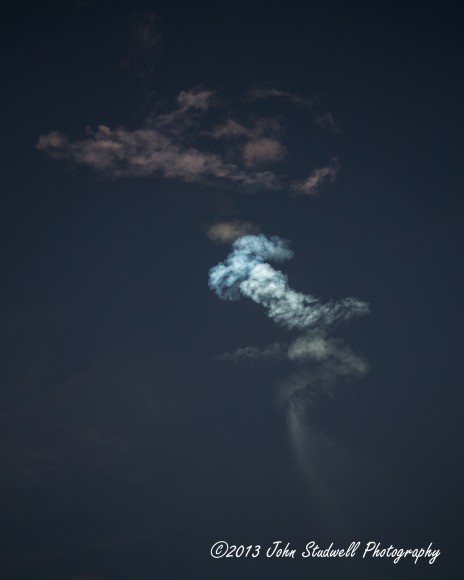
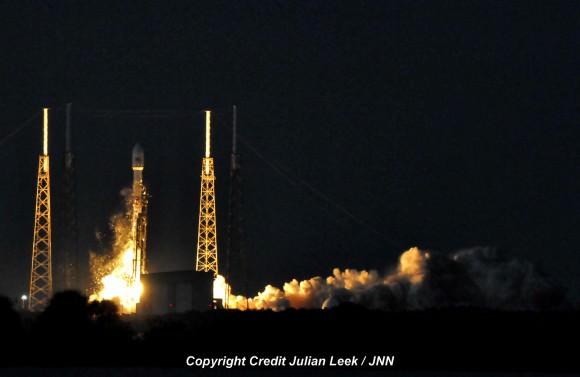
Launch Video
Stay tuned here for continuing SpaceX & MAVEN news and Ken’s SpaceX and MAVEN launch reports from on site at Cape Canaveral & the Kennedy Space Center press site.
…………….
SpaceX Scores Spectacular Success Scorching Florida Sky with Next Gen Rocket
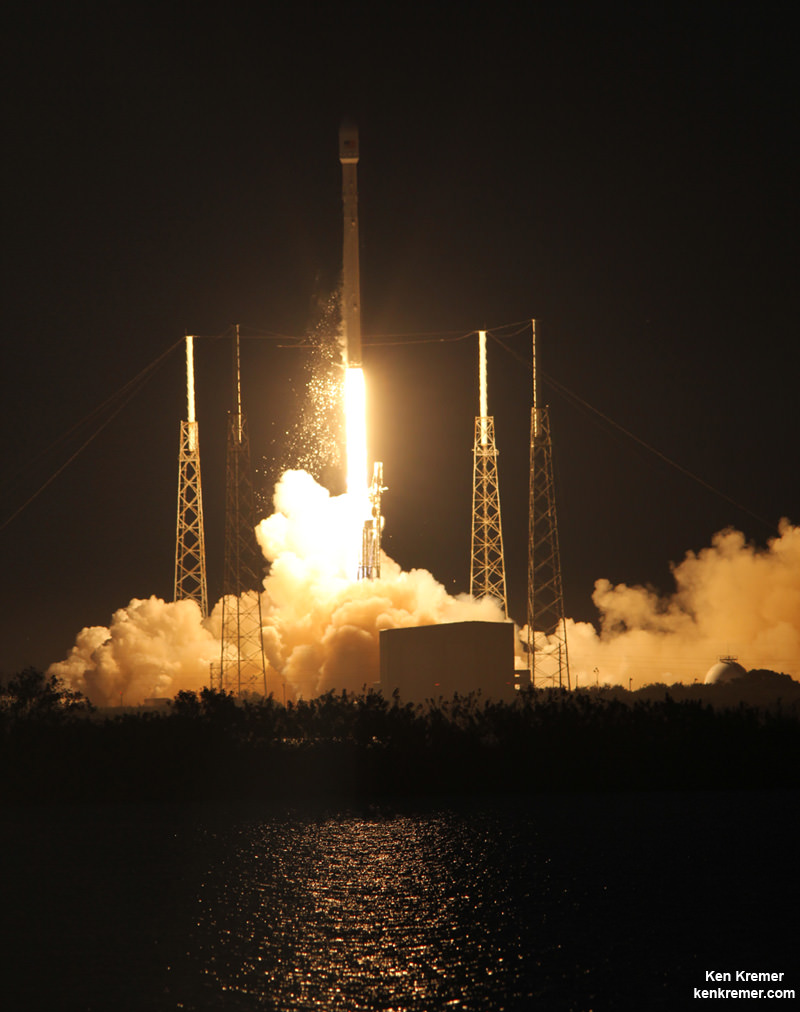
CAPE CANAVERAL AIR FORCE STATION, FL – SpaceX scored a spectacular launch success this evening (Dec. 3 ) when the maiden flight of their upgraded Falcon 9 rocket from Florida scorched the sky of the Florida Space Coast and successfully delivered a commercial space satellite to geostationary orbit for the first time ever – thereby revolutionizing the commercial space industry from this day forward.
The third time was finally the charm as the Falcon 9 blasted off precisely on time at 5:41 p.m. EST from Launch Complex 40 at Cape Canaveral following a pair of launch scrubs last week on Nov. 25 and Thanksgiving Day Nov. 28 caused by technical problems with the first stage engine.
The booster thundered off the pad and pierced the completely cloud free evening sky soon after sunset as the blistering roar rumbled deafeningly all across the space coast viewing area.
The rocket exhaust plume was easily visible for several minutes after liftoff of the historic mission.

The 3,138 kg (6,918 lbs) SES-8 satellite was built by Orbital Sciences for SES and is a hybrid Ku- and Ka-band spacecraft that will provide TV and communications coverage for the South Asia and Asia Pacific regions.
This new version of the Falcon 9 rocket has nearly 50% more thrust compared to the original Falcon 9.
The stakes could not have been higher for the future of SpaceX.
The firms future launch manifest of more than 50 flights for NASA and a variety of commercial entities worth billions of dollars were riding on the success of tonight’s liftoff from Cape Canaveral Air Force Station, Florida.
With 54 satellites in orbit SES is one of the largest commercial telecommunications satellite operators in the world.
The next generation Falcon 9 rocket injected the SES-8 telecommunications to its targeted geostationary transfer orbit flying 295 x 80,000 km above Earth.
A restart of the second stage engine was absolutely essential to the success of the mission since a failure to ignite would have doomed the SES-8 satellite from reaching is desired orbit since it’s a requirement for all geostationary transfer missions.
The picture-perfect flight met 100% of the mission objectives, SpaceX said in a post-launch statement.
“The successful insertion of the SES-8 satellite confirms the upgraded Falcon 9 launch vehicle delivers to the industry’s highest performance standards,” said Elon Musk, CEO and Chief Designer of SpaceX.
“As always, SpaceX remains committed to delivering the safest, most reliable launch vehicles on the market today. We appreciate SES’s early confidence in SpaceX and look forward to launching additional SES satellites in the years to come.”
Today’s launch marked SpaceX’s first commercial launch from Florida as well as the first commercial flight from Cape Canaveral Air Force Station in over five years.
Satellite operators have booked their commercial launches with other rocket companies overseas due to the high cost of other American expendable rockets.
SpaceX’s entire corporate aim has been to significantly cut the high cost of access to space.
“This is really rocking the industry. Everybody has to look out,” said Martin Halliwell, SES chief technical officer, at the prelaunch meeting with reporters including Universe Today.
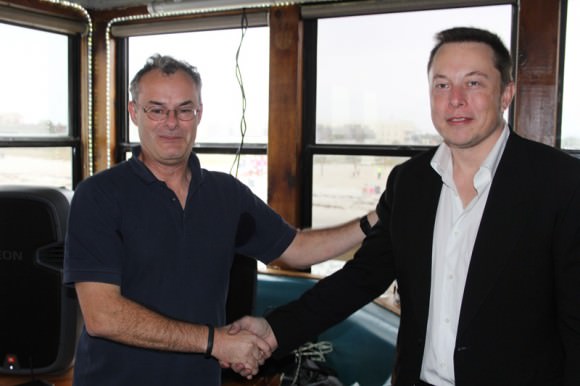
With today’s SpaceX is sure to sign even more contracts bringing additional commercial telecommunications satellite space launches back to American soil.
Approximately 185 seconds into flight, the Falcon 9’s second stage equipped with a single Merlin 1-D engine ignited.
It burned for five minutes and 20 seconds to inject SES-8 satellite into its initial parking orbit.
Eighteen minutes later the second stage engine relit for a second time and fired for just over one minute to deliver SES-8 satellite to its final geostationary transfer orbit.

This extra powerful new version of the Falcon 9 dubbed v1.1 is powered by a cluster of nine of SpaceX’s new Merlin 1D engines that are about 50% more powerful compared to the standard Merlin 1C engines. The nine Merlin 1D engines 1.3 million pounds of thrust at sea level rises to 1.5 million pounds as the rocket climbs to orbit.
The Merlin 1 D engines are arrayed in an octaweb layout for improved efficiency.
Therefore the upgraded Falcon 9 can boost a much heavier cargo load to the ISS, low Earth orbit, geostationary orbit and beyond.
The next generation Falcon 9 is a monster. It measures 224 feet tall and is 12 feet in diameter. That compares to a 130 foot tall rocket for the original Falcon 9.
Stay tuned here for continuing SpaceX & MAVEN news and Ken’s SpaceX launch reports from on site at Cape Canaveral & the Kennedy Space Center press site.
…………….
Learn more about SpaceX, MAVEN, MOM, Mars rovers, Orion and more at Ken’s upcoming presentations
Dec 3/4: “SpaceX launch, MAVEN Mars Launch and Curiosity Explores Mars, Orion and NASA’s Future”, Kennedy Space Center Quality Inn, Titusville, FL, 8 PM
Dec 11: “Curiosity, MAVEN and the Search for Life on Mars”, “LADEE & Antares ISS Launches from Virginia”, Rittenhouse Astronomical Society, Franklin Institute, Phila, PA, 8 PM
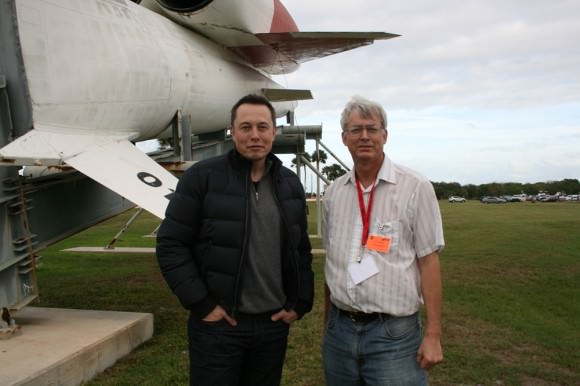
Upper Stage Engine Restart Essential to High Stakes SpaceX Mission Success for Dec. 3 Launch Attempt
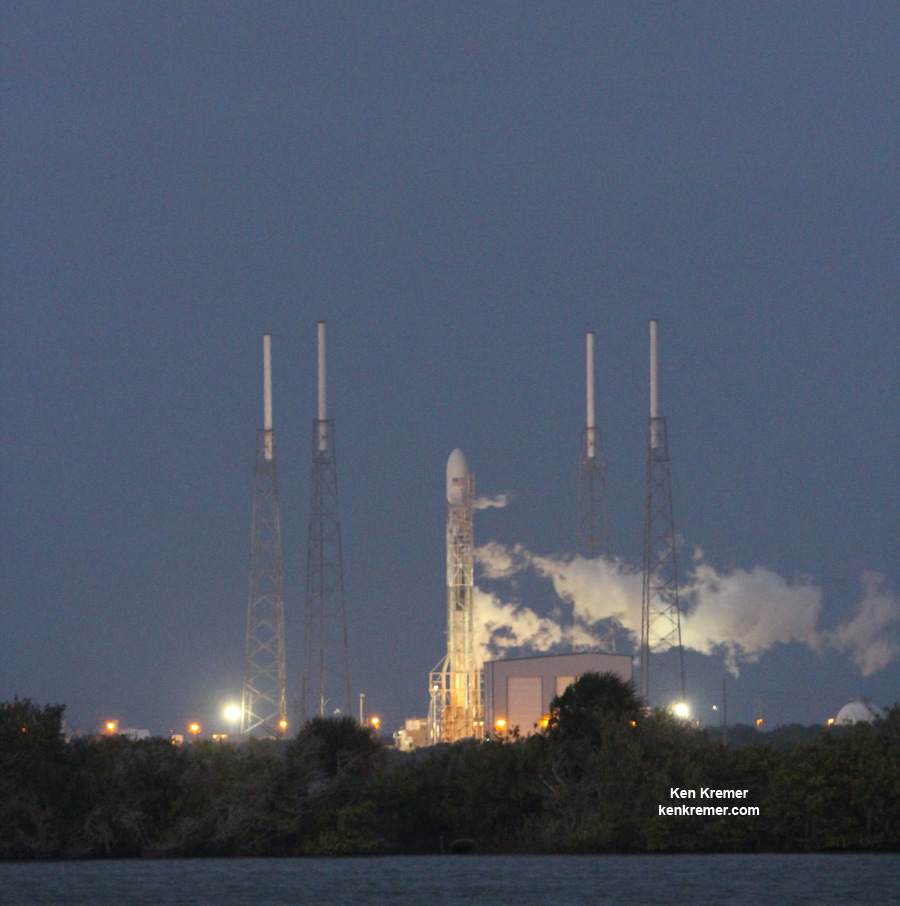
CAPE CANAVERAL, FL – Today (Dec. 3) marks the 3rd attempt by SpaceX to launch the maiden flight of their significantly upgraded Falcon 9 rocket with the SES-8 telecommunications satellite – following the Nov. 28 ‘Thanksgiving = Spacegiving Day’ scrub due to an aborted 1st stage engine firing in progress.
And the stakes could not be higher for the future of SpaceX – with the firms future launch manifest worth billions of dollars riding on the success of today’s liftoff from Cape Canaveral Air Force Station, Florida.
In an unprecedented launch event for SpaceX, the upper stage engine on the next generation Falcon 9 booster absolutely must restart in flight for a second time in order for the commercial SES-8 payload to be delivered to geostationary transfer orbit (GTO).
Blastoff from Cape Canaveral’s seaside Space Launch Complex 40 is set for 5:41 p.m. EST (2241 GMT).
The Thanksgiving Day launch was aborted by the computers when the Marlin engines thrust failed to build up as fast as planned.
The weather forecast currently shows a 90% chance of favorable conditions at liftoff time according to Air Force meteorologists. The only concern is for winds.
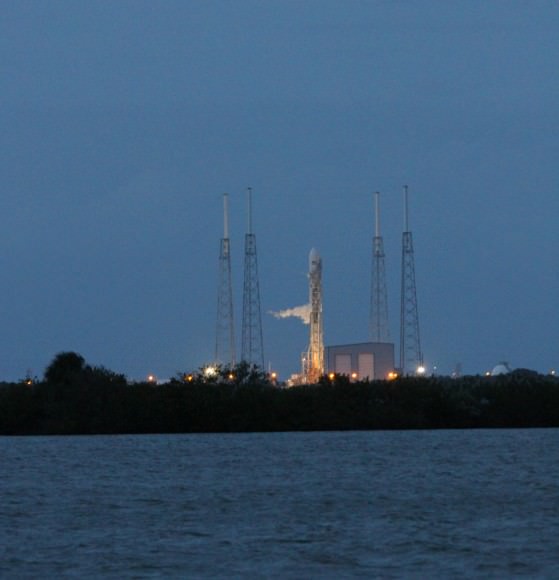
The launch of SES-8 is a milestone marking the first ever attempt by SpaceX to place a satellite into the geostationary orbit replete with numerous high value commercial satellites. This is the doorway to the future profitability of SpaceX.
“I don’t want to tempt fate, but I think it’s going to have a pretty significant impact on the world launch market and on the launch industry because our prices are the most competitive of any in the world,” said SpaceX CEO and chief designer Elon Musk at a prelaunch briefing for media including Universe Today in Cocoa Beach, FL.
For the mission to be declared a success, the upper stage engine must reignite precisely as planned about 27 minutes after liftoff and burn for approximately 1 minute to successfully propel SES-8 into the propel orbit about 33 minutes after launch.

“Whether or not this launch is successful, I’m confident we will certainly make it on some subsequent launch,” said Musk.
“This is really rocking the industry. Everybody has to look out,” said Martin Halliwell, SES chief technical officer, who joined Musk at the prelaunch meeting.
The upgraded Falcon 9 will also be the launcher utilized for the manned SpaceX Dragon capsules launching to the ISS sometime later this decade!
And the very next satellite set for launch by SpaceX later in December – Thaicom 6- is essentially already waiting at the door to the onramp to space.
SpaceX plans a live broadcast of the Falcon 9 liftoff from pad 40 on Cape Canaveral Air Force Station, FL beginning at 5 p.m. EST.
It can be viewed here: www.spacex.com/webcast
The show will feature commentary about the Falcon 9 rocket and launch sequences and the SES-8 commercial satellite from SpaceX corporate headquarters in Hawthorne, CA.
The Falcon 9/SES-8 launch window extends for 86 minutes until 7:07 p.m. EST.
The 3,138 kg (6,918 lbs) SES-8 satellite is a hybrid Ku- and Ka-band spacecraft that will provide TV and communications coverage for the South Asia and Asia Pacific regions.
This mighty new version of the Falcon 9 dubbed v1.1 is powered by a cluster of nine of SpaceX’s new Merlin 1D engines that are about 50% more powerful compared to the standard Merlin 1C engines. The nine Merlin 1D engines 1.3 million pounds of thrust at sea level that rises to 1.5 million pounds as the rocket climbs to orbit
The Merlin 1-D engines are arrayed in an octaweb layout for improved efficiency.
Therefore the upgraded Falcon 9 can boost a much heavier cargo load to the ISS, low Earth orbit, geostationary orbit and beyond.
The next generation Falcon 9 is a monster. It measures 224 feet tall and is 12 feet in diameter. That compares to 13 stories for the original Falcon 9.
Stay tuned here for continuing SpaceX & MAVEN news and Ken’s SpaceX launch reports from on site at Cape Canaveral & the Kennedy Space Center press site.
All is GO for SpaceX Thanksgiving Day Launch that could ‘Rock’ Space Industry – Live Webcast
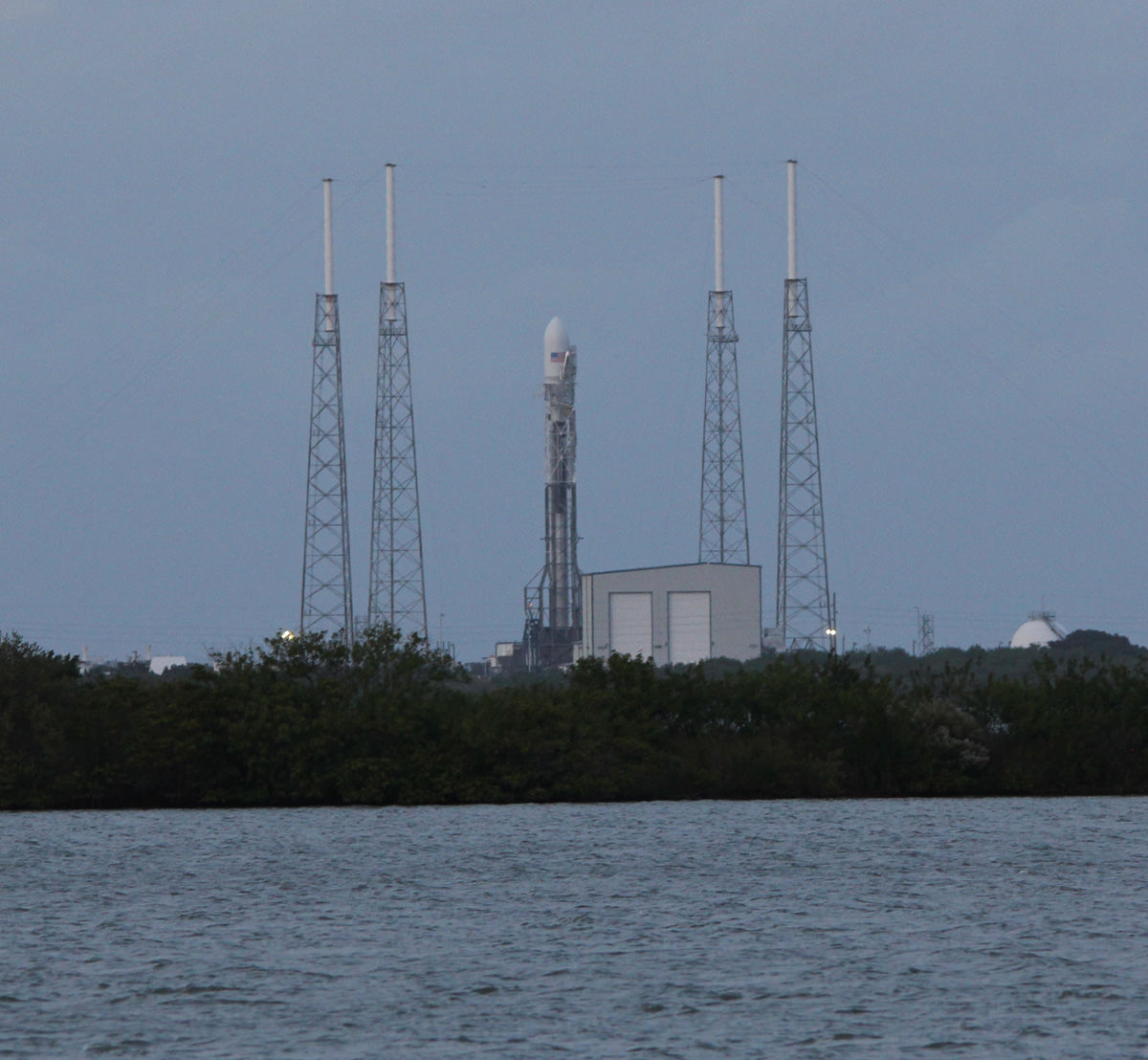
UPDATE: The launch was scrubbed one second before liftoff at 5:39 p.m. EST Thursday. Computers sensed the Falcon 9’s rocket thrust was building up too slowly. No new launch date was immediately set.
CAPE CANAVERAL, FL – All Systems are “GO” for today’s Thanksgiving Day blastoff of the upgraded SpaceX Falcon 9 rocket that could quite literally ‘rock the space industry to its core’ – If all goes well.
Following Monday’s (Nov. 25) scrub during to a series of technical glitches, the rocket, launch pad systems and weather are all cooperating and ready to support the maiden blastoff of the next generation Falcon 9 rocket from Launch Complex 40 at 5:39 p.m. EST.
SpaceX is offering a live webcast of today’s ‘Spacegiving Day’ launch – as they’ve dubbed it.
The live broadcast of the Falcon 9 liftoff from pad 40 on Cape Canaveral Air Force Station, FL begins at 5 p.m. EST and can be viewed here: www.spacex.com/webcast.
The show will feature commentary about the Falcon 9 rocket and launch sequences and the SES-8 commercial satellite from SpaceX corporate headquarters in Hawthorne, CA.
The Falcon 9/SES-8 launch window extends for 65 minutes.

Today’s (Nov. 28) inaugural launch of the privately developed Falcon 9 rocket with the commercial SES-8 HDTV and telecommunications satellite is especially noteworthy because it also features SpaceX’s first ever launch of any satellite to a Geostationary Transfer Orbit (GTO).
The 3,138 kg (6,918 lbs) SES-8 satellite is a hybrid Ku- and Ka-band spacecraft that will provide TV and communications coverage for the South Asia and Asia Pacific regions.
The Falcon 9 liftoff was postponed to Thanksgiving Day because the FAA did not grant SpaceX a launch permit on Tuesday and Wednesday out of concern it would have significantly impacted allowable flight paths for commercial airliners on two of the busiest travel days of the year, said SpaceX CEO Elon Musk at a media briefing.

The weather forecast currently shows a 90% chance of favorable conditions at liftoff time according to Air Force meteorologists. The only concern is for winds.
The last time a rocket launched on Thanksgiving Day from Cape Canaveral was back in 1959. It involved an Atlas Able rocket with the Pioneer P-3 lunar probe and failed.
Stay tuned here for continuing SpaceX & MAVEN news and Ken’s SpaceX launch reports from on site at Cape Canaveral & the Kennedy Space Center press site.
…………….
Learn more about SpaceX, MAVEN, MOM, Mars rovers, Orion and more at Ken’s upcoming presentations
Nov 28: “SpaceX launch, MAVEN Mars Launch and Curiosity Explores Mars, Orion and NASA’s Future”, Kennedy Space Center Quality Inn, Titusville, FL, 8 PM
Dec 11: “Curiosity, MAVEN and the Search for Life on Mars”, “LADEE & Antares ISS Launches from Virginia”, Rittenhouse Astronomical Society, Franklin Institute, Phila, PA, 8 PM
Elon Musk Briefs Universe Today & Media ahead of Revolutionary Falcon 9 Blastoff
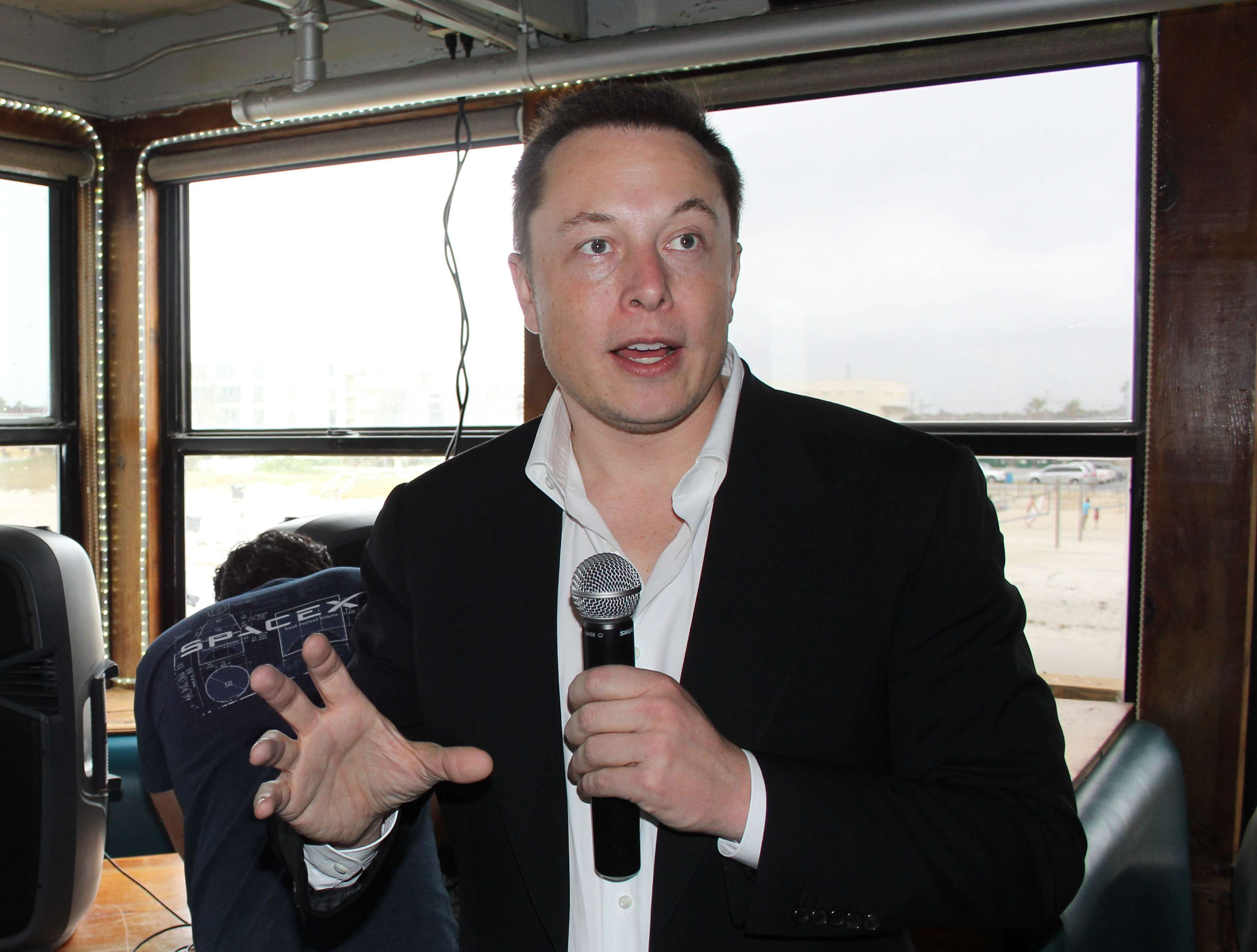
SpaceX founder and CEO Elon Musk briefs reporters including Universe Today on Sunday (Nov. 24) in Cocoa Beach, FL prior to planned SpaceX Falcon 9 rocket blastoff with SES-8 communications satellite set for Nov. 25, 2013 from Cape Canaveral, FL. Credit: Ken Kremer/kenkremer.com
See live SpaceX webcast link below[/caption]
CAPE CANAVERAL, FL – A new space era potentially dawns today, Nov. 25, with the planned maiden launch of the next generation SpaceX Falcon 9 commercial rocket from Cape Canaveral, FL, that could completely revolutionize how we access the high frontier and “rock the space industry to its core” by cutting cost and production times – if all goes well.
Just a day before liftoff, SpaceX founder and CEO Elon Musk personally briefed reporters including Universe Today on Sunday (Nov. 24) in Cocoa Beach, FL, nearby the firms Cape Canaveral launch facility about today’s (Nov. 25) upcoming maiden launch of the companies upgraded Falcon 9 rocket, saying it was “very important” for the future.
“This launch is very important to the future of SpaceX. This is our toughest mission yet!” said Musk to a small group of reporters, including the author, gathered for Sunday’s exclusive pre-launch briefing.
“Whether or not this launch is successful, I’m confident we will certainly make it on some subsequent launch,” said Musk at the Cocoa Beach meeting with the media.
The Falcon 9 liftoff from Launch Complex 40 at Cape Canaveral, FL is scheduled for 5:37pm EST and will be webcast live by SpaceX for viewing at; www.spacex.com/webcast
Today’s (Nov. 25) inaugural blastoff of the privately developed Falcon 9 rocket with the commercial SES-8 HDTV and telecommunications satellite is especially noteworthy because it also features SpaceX’s first ever launch of any satellite to a Geostationary Transfer Orbit (GTO).
From the start, SpaceX designed the Falcon 9 rocket from a clean sheet aimed at radically reducing production and manufacturing costs and assembly times and thereby offer significantly lower launch price, says Musk.
“I don’t want to tempt fate, but I think it’s going to have a pretty significant impact on the world launch market and on the launch industry because our prices are the most competitive of any in the world,” Musk stated.

SES-8 also represents SpaceX’s first launch of a Falcon 9 carrying a commercial satellite to space from the Florida Space Coast.
“This is really rocking the industry. Everybody has to look out,” said Martin Halliwell, SES chief technical officer, who joined Musk at Sunday’s meeting.
The 3,138 kg (6,918 lbs) SES-8 satellite is a hybrid Ku- and Ka-band spacecraft that will provide TV and communications coverage for the South Asia and Asia Pacific regions.
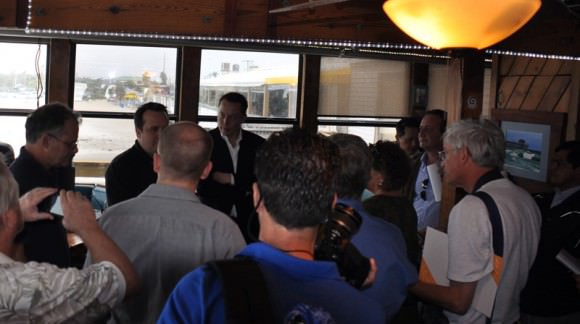
The SES-8 spacecrft was built by Orbital Sciences Corp and will be lofted to a 295 x 80,000 km geosynchronous transfer orbit inclined 20.75 degrees.
SpaceX has signed nearly 50 commercial and government launch contracts and thus already sports a very crowded launch manifest ahead of today’s Falcon 9 launch.
All five launches of SpaceX’s Falcon 9 rocket from Space Launch Complex 40 at Cape Canaveral Air Force Station were either test launches or flights to the International Space Station, under contract to NASA.
The five Falcon 9 launches to date from the Florida Space Coast also featured the original, less powerful and shorter version of the booster and has a 100% success rate.
This mighty new version of the Falcon 9 dubbed v1.1 is powered by a cluster of nine of SpaceX’s new Merlin 1D engines that are about 50% more powerful compared to the standard Merlin 1C engines. The nine Merlin 1D engines 1.3 million pounds of thrust at sea level that rises to 1.5 million pounds as the rocket climbs to orbit.
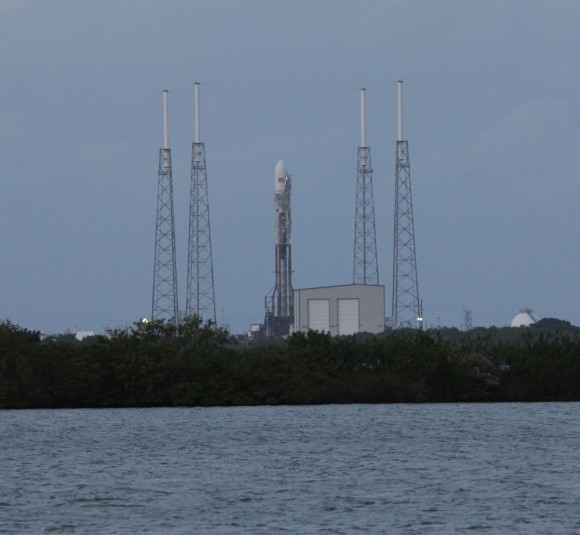
Therefore the upgraded Falcon 9 can boost a much heavier cargo load to the ISS, low Earth orbit, geostationary orbit and beyond.
The next generation Falcon 9 is a monster. It measures 224 feet tall and is 12 feet in diameter. That compares to 13 stories for the original Falcon 9.
The payload fairing for SES-8 is 17 feet in diameter.
The Falcon 9/SES-8 launch window extends for 66 minutes until 6:43 p.m. EST.
Weather outlook is 80% favorable at this time.
SpaceX is planning a live webcast of the launch with commentary from SpaceX corporate headquarters in Hawthorne, CA.
The broadcast will begin at approximately 5:00 p.m. EDT and include detailed discussions about the Falcon 9 rocket, launch and flight sequences as well as about the SES-8 satellite.
Stay tuned here for continuing SpaceX & MAVEN news and Ken’s SpaceX launch reports from on site at Cape Canaveral & the Kennedy Space Center press site.
…………….
Learn more about SpaceX, LADEE, MAVEN, MOM, Mars rovers, Orion and more at Ken’s upcoming presentations
Nov 22-25: “SpaceX launch, MAVEN Mars Launch and Curiosity Explores Mars, Orion and NASA’s Future”, Kennedy Space Center Quality Inn, Titusville, FL, 8 PM
Dec 11: “Curiosity, MAVEN and the Search for Life on Mars”, “LADEE & Antares ISS Launches from Virginia”, Rittenhouse Astronomical Society, Franklin Institute, Phila, PA, 8 PM
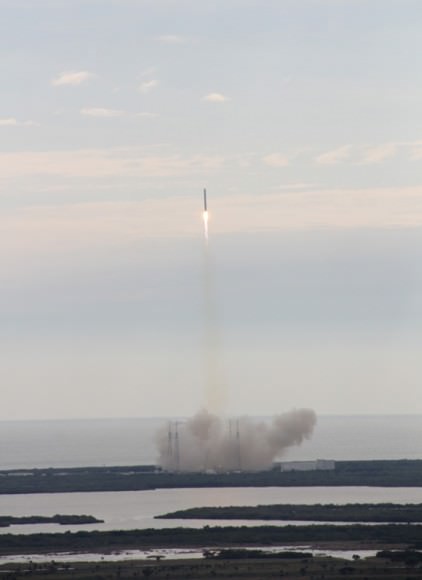
Maiden Next Gen SpaceX Falcon 9 launch from Cape Canaveral set for Nov. 25
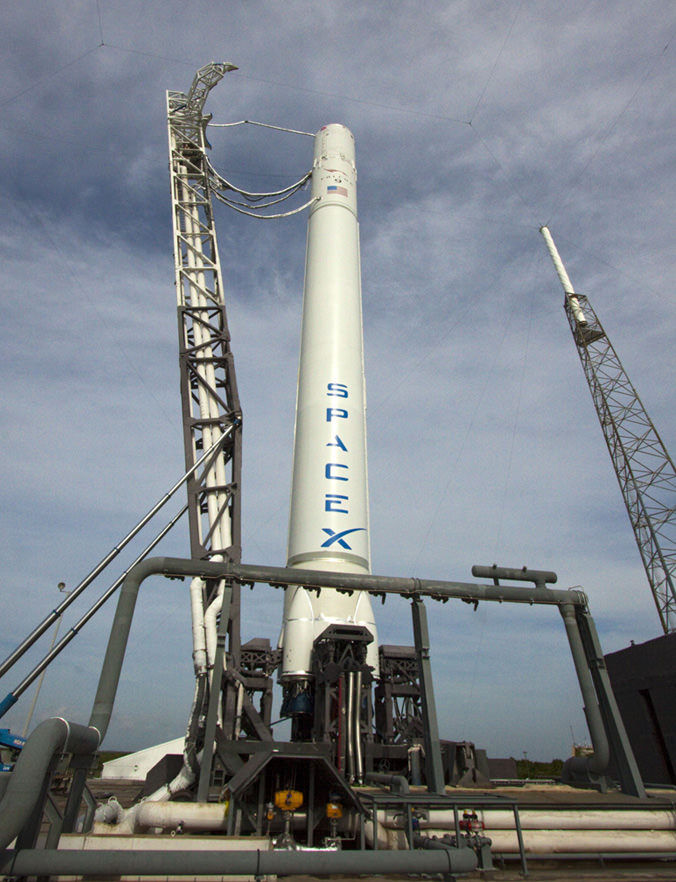
Falcon 9 during processing at Cape Canaveral Pad 40 ahead of launch scheduled for Nov. 25, 2013. Credit: SpaceX
See live SpaceX webcast link below[/caption]
CAPE CANAVERAL, FL – The maiden flight of the Next Generation commercial SpaceX Falcon 9 rocket from the firms Cape Canaveral launch facility is set to soar to space on Monday afternoon, Nov. 25 on a ground breaking mission that will be most difficult ever.
The upgraded Falcon 9 booster is slated to haul the commercial SES-8 telecommunications satellite for the satellite provider SES for SpaceX’s first ever payload delivery to a Geostationary Transfer Orbit (GTO).
Liftoff is scheduled for 5:37 p.m. EST from SpaceX’s Space Launch Complex 40 pad at Cape Canaveral Air Force Station.
Pad 40 is the same location as all prior SpaceX launches from the Florida Space Coast.
SpaceX CEO Elon Musk tweeted that this launch of the Falcon 9 will be the “toughest mission to date.”

This mighty new version of the Falcon 9 dubbed v1.1 is powered by a cluster of nine of SpaceX’s new Merlin 1D engines that are about 50% more powerful compared to the standard Merlin 1C engines. Therefore it can boost a much heavier cargo load to the ISS, low Earth orbit and beyond.
The next generation Falcon 9 is a monster. It’s much taller than a standard Falcon 9 – some 22 stories tall vs. 13 stories.
In anticipation of Monday’s planned liftoff, SpaceX engineers successful completed a wet dress rehearsal and engine hotfire test this past Thursday.
Spectators can view the launch from local public areas, beaches and roads – just as with any other liftoff.
The launch window extends just over an hour until 6:43 p.m. EST.
Weather outlook is 80% favorable at this time but deteriorates in case of a 1 day delay to Tuesday.

SpaceX is planning a live webcast of the launch with commentary from SpaceX corporate headquarters in Hawthorne, CA.
The broadcast will begin at approximately 5:00 p.m. EDT and include detailed discussions about the Falcon 9 rocket, launch and flight sequences as well as about the SES- 8 satellite.
The webcast can be viewed at; www.spacex.com/webcast
The first launch of this next generation Falcon 9 v 1.1 rocket occurred on Sept 29, 2013 on a demonstration test flight from a SpaceX pad at Vandenberg AFB carrying a Canadian weather satellite to an elliptical earth orbit.
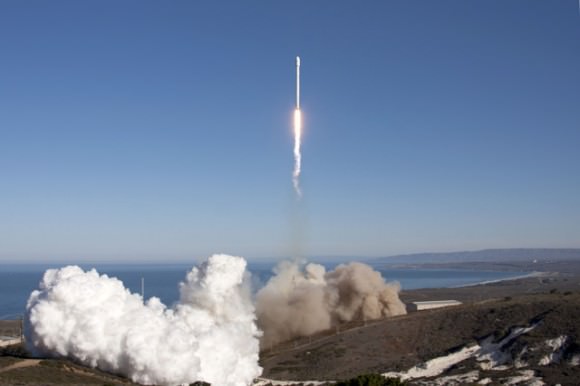
SES-8 is a hybrid Ku- and Ka-band spacecraft that will provide communications coverage for the South Asia and Asia Pacific regions.
It was built by Orbital Sciences spacecraft, weighs 3,138 kg (6,918 lbs) and will be lofted to a 295 x 80,000 km geosynchronous transfer orbit inclined 20.75 degrees.
Stay tuned here for continuing SpaceX & MAVEN news and Ken’s SpaceX launch reports from on site at Cape Canaveral & the Kennedy Space Center press site.
…………….
Learn more about SpaceX, LADEE, MAVEN, MOM, Mars rovers, Orion and more at Ken’s upcoming presentations
Nov 22-25: “SpaceX launch, MAVEN Mars Launch and Curiosity Explores Mars, Orion and NASA’s Future”, Kennedy Space Center Quality Inn, Titusville, FL, 8 PM
Dec 11: “Curiosity, MAVEN and the Search for Life on Mars”, “LADEE & Antares ISS Launches from Virginia”, Rittenhouse Astronomical Society, Franklin Institute, Phila, PA, 8 PM
Human Spaceflight, Planetary Missions Face Potential Cuts in Latest NASA Budget Negotiations
While 2014 budget negotiations are not finalized yet, there’s already some noise of concern in different space communities that depend on NASA. Here’s a brief roundup of some of the news lately:
Could the Cassini Saturn mission get the axe? Wired’s Adam Mann warns that NASA may not be able to fund all of its planetary science missions in the coming year. Based on a statement that Jim Green, NASA’s planetary science director, made to an agency advisory council earlier this month, Mann narrows in on the Curiosity and Cassini missions as the big flagship missions that are requiring the most in terms of resources. Cassini is functioning perfectly and providing reams of data from Saturn and its moons, causing concern from planetary scientists about losing it early.
Only one commercial crew partner? NASA issued a cautious news release this week saying it is prepared to launch Americans from their own soil in 2017, “subject to the availability of adequate funding.” The agency is now moving into a new phase of its commercial crew program called Commercial Crew Transportation Capability (CCtCap), saying it is prepared to “award one or more CCtCap contracts no later than September 2014.” That means that the three companies currently funded — Boeing Co., Sierra Nevada Corp. and SpaceX — may face stiff competition for more money.
New report suggesting stopping NASA’s human spaceflight program: Before reading any further, do not jump to conclusions — making recommendations like this is a common practice by the Congressional Budget Office, which looks at all possibilities as it presents options for spending. Still, Space Politics’ Jeff Foust presents the report and generates some interesting comments after his story about the value of human spaceflight. For context, NASA and its international agency partners will need to make a decision fairly soon about continuing space station operations past 2020, so it’s possible the human spaceflight program could change.
What do you think of these proposals? Let us know in the comments.
Incredible Vertical-Landing Grasshopper Rocket Has Retired
Did you take a moment to look at that August video of the Grasshopper rocket deliberately going sideways and then appearing to hover for a bit before returning to Earth? For more video fodder, there’s also this high-flying test the rocket took in October.
We hope you enjoyed these views, because Grasshopper is being retired. SpaceX now wants to focus its energy and resources on to the larger Falcon 9-R first stage, which should see its first test flight in New Mexico this December.
It sounds like SpaceX would have loved to go further, in a sense. “In some ways we’ve kind of failed on the Grasshopper program because we haven’t pushed it to its limit,” SpaceX president Gwynne Shotwell said at the International Symposium for Personal and Commercial Spaceflight (ISPCS) in New Mexico last week, as reported in the NewSpace Journal. “We haven’t broken it.”
Grasshopper took eight test flights during its flight history, which spanned about a year between September 2012 and October 2013. It was intended to test Vertical Takeoff Vertical Landing technology (VTVL). The strange appearance of a rocket leaving Earth and gently, deliberately touching back down again turned heads — even in the general public.
We have coverage — and videos! — of most of its past test flights here (the dates below are flight dates, not publication dates)
- November 1, 2012: Flight to 106 feet (32 meters).
- December 17, 2012: Flight to 131 feet (40 meters).
- March 7, 2013: Flight to 262.8 feet (80.1 meters).
- April 17, 2013: Flight to 820 feet (250 meters).
- August 13, 2013: Divert maneuver!
- October 13, 2013: Highest test flight yet (2,440 feet or 744 meters).
Most rockets are single-use only and are discarded either in orbit or (better yet, for space debris concerns) are put in a path to burn up in Earth’s atmosphere. SpaceX, however, wants its next-generation Falcon 9 rocket to have a reusable first stage to cut down on launch costs. (Grasshopper was about 10 storeys high, while the Falcon 9 will be about 14 storeys tall when carrying a Dragon spacecraft on board.)
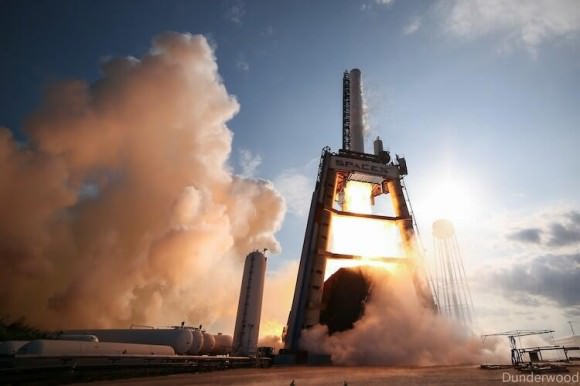
As for the Falcon 9 series, a rocket flight in September delivered its payload (which included the Canadian Cassiope satellite) to space successfully, but faced some technical problems with the upper stage — and the first stage, as the rocket was supposed to be slowed down for splashdown.
As Space News reported, two burns were planned. The first worked, but the second burn took place while the rocket was spinning, which affected the flow of fuel. A picture shown by SpaceX demonstrated the rocket was intact three meters above the ocean, although it did not survive after it hit.
“Between the flights we’ve been doing with Grasshopper and this demonstration that we brought that stage back, we’re really close to full and rapid reuse of stages,” Shotwell said in the report.
Cygnus Commercial Cargo Craft Completes Historic First Flight to Space Station
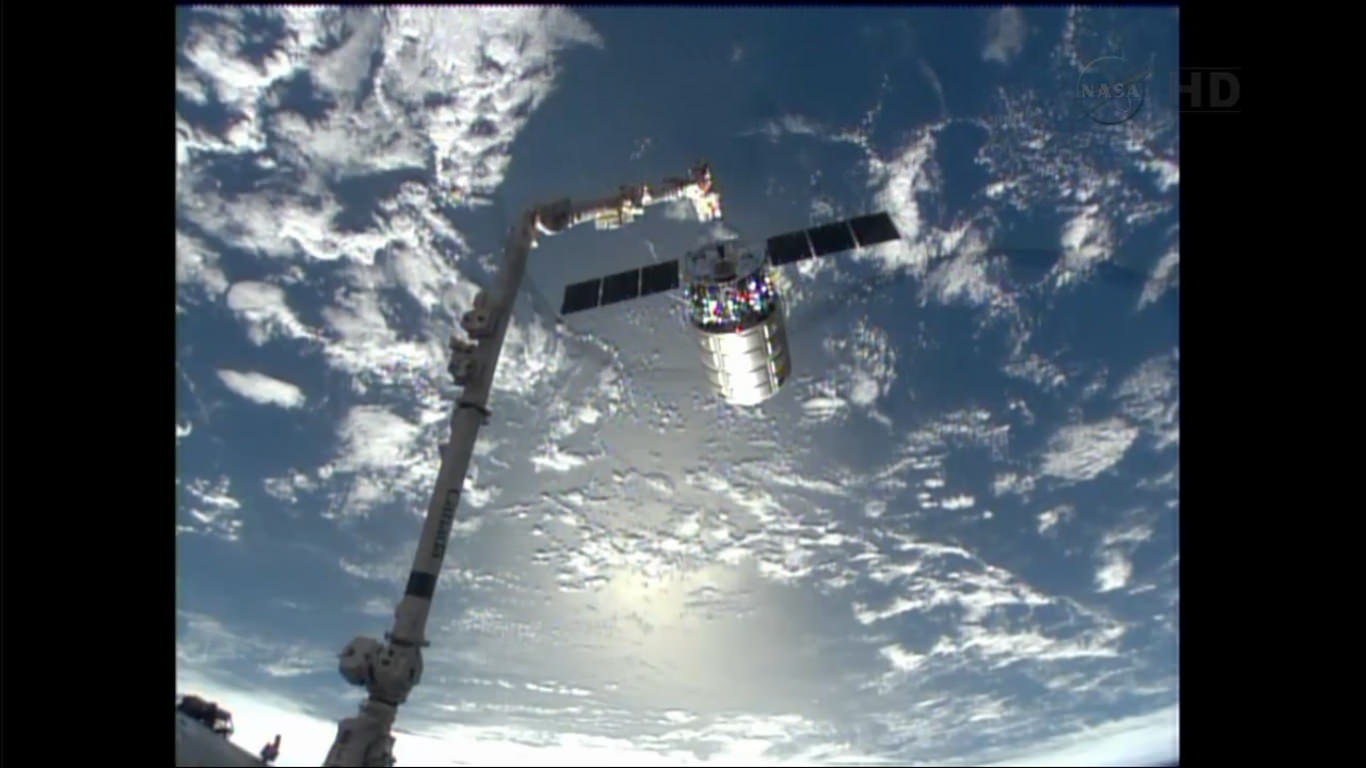
Commercial space took another major leap forward this morning, Oct 22., when the privately developed Cygnus cargo vehicle undocked from the International Space Station on its historic maiden flight and successfully completed a highly productive month long stay during its demonstration mission – mostly amidst the US government shutdown.
The Cygnus was maneuvered about 10 meters (30 feet) away from the station and held in the steady grip of the stations fully extended robotic arm when astronauts Karen Nyberg and Luca Parmitano unlatched the arm and released the ship into free space at 7:31 a.m. EDT today – signifying an end to joint flight operations.
The next Cygnus resupply vessel is due to blast off in mid-December and is already loaded with new science experiments for microgravity research and assorted gear and provisions.
After the Expedition 37 crew members quickly pulled the arm back to a distance 1.5 meters away from Cygnus, ground controllers issued a planned “abort” command to fire the ships thrusters and safely depart from the massive orbiting lab complex.
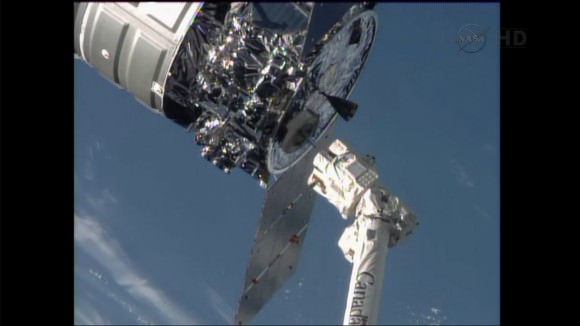
“It’s been a great mission. Nice work today!” radioed Houston Mission Control at NASA’s Johnson Space Center.
The vehicles were flying over the Atlantic Ocean and off the east coast of Argentina as Cygnus left the station some 250 miles (400 km) overhead in low Earth orbit.
The event was carried live on NASA TV and Cygnus was seen moving rapidly away.
Barely five minutes later Cygnus was already 200 meters away, appeared very small in the cameras view and exited the imaginary “Keep Out Sphere” – a strictly designated safety zone around the million pound station.
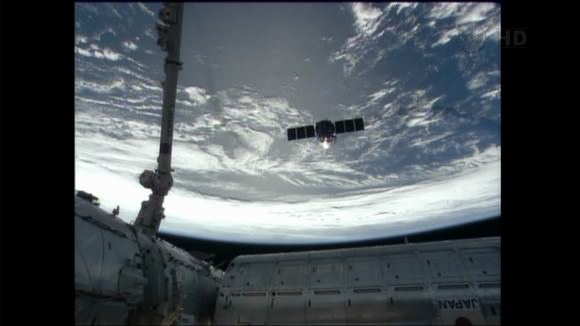
The Cygnus resupply ship delivered about 1,300 pounds (589 kilograms) of cargo, including food, clothing, water, science experiments, spare parts and gear to the six person Expedition 37 crew.
After the crew unloaded all that cargo, they packed the ship with 2,850 pounds of no longer needed trash.
On Wednesday (Oct. 23), a pair of deorbit burns with target Cygnus for a destructive reentry back into the Earth’s atmosphere at 2:18 p.m. EDT, to plummet harmlessly into the Pacific Ocean.
Cygnus was developed by Orbital Sciences Corp. with seed money from NASA in a public-private partnership between NASA and Orbital Sciences under NASA’s COTS commercial transportation initiative.
SpaceX Corp. was also awarded a COTS contract to develop the Dragon cargo carrier so that NASA would have a dual capability to stock up the station.
COTS was aimed at fostering the development of America’s commercial space industry to deliver critical and essential supplies to the ISS following the retirement of the Space Shuttle program.
“Congratulations to the teams at Orbital Sciences and NASA who worked hard to make this demonstration mission to the International Space Station an overwhelming success,” NASA Administrator Charles Bolden said in a statement.
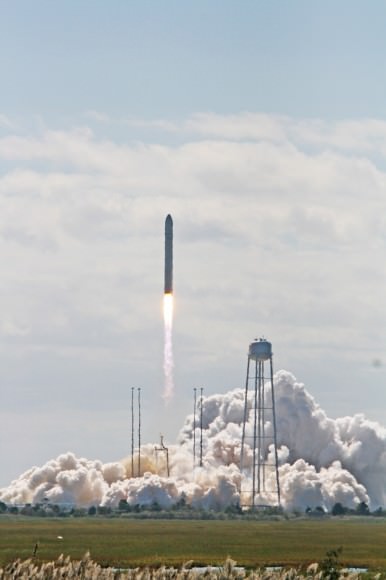
“We are delighted to now have two American companies able to resupply the station. U.S. innovation and inspiration have once again shown their great strength in the design and operation of a new generation of vehicles to carry cargo to our laboratory in space. Orbital’s success today is helping make NASA’s future exploration to farther destinations possible.”
America completely lost its capability to send humans and cargo to the ISS when NASA’s space shuttles were forcibly retired in 2011. Orbital Sciences and SpaceX were awarded NASA contracts worth over $3 Billion to restore the unmanned cargo resupply capability over 20 flights totally.
Cygnus was launched to orbit on its inaugural flight on Sept. 18 atop Orbital’s commercial Antares rocket from NASA’s Wallops Flight Facility on the Eastern shore of Virginia.
The initially planned Sept. 22 berthing of the spacecraft at a port on the Earth facing Harmony node was delayed a week to Sept. 29 due to an easily fixed communications glitch. It was no worse for the wear and performed admirably.
“Antares next flight is scheduled for mid December,” according to Frank Culbertson, former astronaut and now Orbital’s executive Vice President responsible for the Antares and Cygnus programs.
